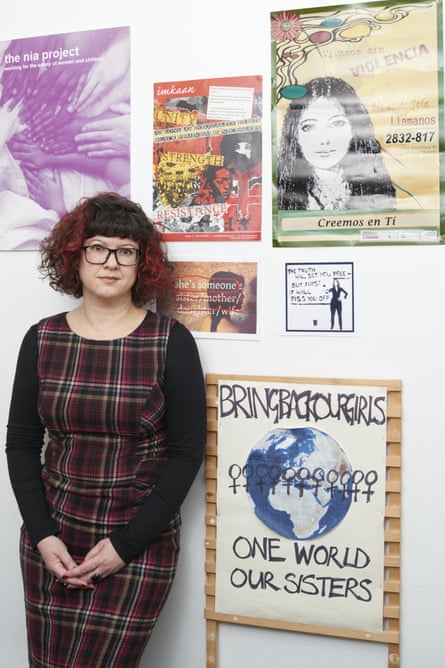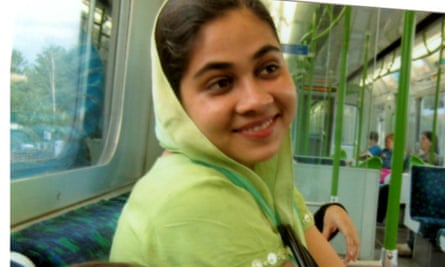With neat rows of photographs of smiling women old and young, of all backgrounds, classes and creeds, it might be pages from a social media website or something from an advertising campaign. Hundreds of women, captured in a moment of vitality and life, at home, at parties, on holidays or with friends.
Behind the pictures lie stories of women who, beyond their families, have been remembered chiefly as statistics. But they should be linked, says campaigner Karen Ingala Smith, because they were all killed by men.
On Thursday a database will be launched online entitled Femicide Census: Profiles of Women Killed by Men. It is a project designed to force a recognition of the scale and significance of male violence against women and is the culmination of several years of work by Ingala Smith, who began a grim and time-consuming task of counting Britain’s murdered women and putting their names on her own blog back in 2012. There were 126 women killed through male violence that year, 143 in 2013 and 150 in 2014.
Scouring news websites and police reports, she pieced together what she says is an important pattern that was not being represented in the way crime and other statistics are collated. It became a personal tribute, too: “It’s really hard sometimes and I admit I’ve had a cry now and again. A photo captures a moment in time that trials don’t. A moment of the person who that woman was. What suffering she endured, and the suffering that continues for their family is so very hard to grasp.”
The database launch, by Ingala Smith – chief executive of London-based domestic violence charity Nia Project – together with Women’s Aid and the legal firm Freshfields, will mean a public tally of the dead is kept in a more formal manner, using police statistics as well as court reports. The site will be used to store as much information as possible on the background and the crime, available for approved subscribers – the first time such details have been held together – to make research and studies easier.

The Home Office now records and publishes data on homicide victims and the relationship of the victim to the principal suspect and sex of the victim. But it does not have the sex of the killer or connect different forms of male violence against women. The Femicide project will have to gain some of its information through presenting freedom of information requests to police forces every six months – something Ingala Smith hopes might be avoided if they can be persuaded to collate their figures in a different way, allowing easier access to statistics on men killing women.
Things have improved dramatically in the UK since the days when “wife-beating” was the stuff of jokes and marital rape was not a criminal offence – it finally became illegal for a man to rape his wife in 1991. The government has now made it mandatory for a “domestic violence homicide review” to be held every time someone is killed in that manner – although the results are often buried away on local authority websites. Refuge, the national charity for abused women and children, has just launched a campaign calling on the government to open a public inquiry to investigate why victims of domestic violence are still not getting the protection they deserve from the police and other state agencies.
Women’s Aid points to the increasing pressure on help services for victims of domestic abuse – its survey found that more than 74,000 women sought help in 2013-14. The same report said that on just one day in 2014 112 women and 84 children were turned away from refuges because they could not be accommodated and 369 women were denied help from outreach services in the community because of a lack of capacity. The charity believes lives are lost every year because there is no national network of women’s refuges.
Ingala Smith says men and women have to confront the situation. “I want us to stop seeing the killings of women by men as isolated incidents: to put them together and to see the connections and patterns; to highlight what a big issue it is; and to make it feel real for people,” she said. “Many people will now know the statistic for people killed by a partner or ex-partner; that two women a week in England and Wales die that way. But if you humanise that, and you can see that roll of names, then hopefully more people might think: well, there is a pattern going on here. If we continue as I think most of us are,, to deny that this is something that’s happening, then we will never tackle it.”
The issue is not confined to women who have been killed by their partners or former partners in incidents of domestic violence, campaigners say, but extends to all women killed by men. “I started off counting women who had been killed in domestic violence after I noticed that, in the first three days of January 2012, eight women had been killed,” she said. “But then I started to realise there was a pattern in other deaths of women at men’s hands. What shocked me was seeing the women killed by a male child. It’s still quite rare, but we certainly don’t see daughters killing their fathers the way we have mothers being killed.” Even if a mugger or burglar causes the death of an elderly woman, she said, if there is a pattern of that man targeting vulnerable women it arguably puts him in the same category as a domestic abuser.
When, in 2012, Ahmad Otak stabbed and killed Samantha Sykes, 18, and Kimberley Frank, 17, Otak was not the boyfriend of either of them but of Kimberley’s sister. Ingala Smith said it was this case that made her realise the issue was wider than domestic violence. She said the case made her realise such crimes were just as much about male violence against women as if the perpetrator had been a boyfriend of husband. And for those who say, “Where can I find the page for dead men?”, she says she would go ahead and make one, “but no one can change the fact that overwhelmingly the victim of domestic violence is a woman”.
Official figures show that, between 2002 and 2012, 6.1% of adults who were convicted of murder were women, leaving 93.9% men. Although she acknowledges that violence is perpetrated by women sometimes and that it should be taken seriously, it is not the major issue. “People are falling for the line that women can be violent too,” she said. “Men kill men, obviously. But nearly always when a woman kills a man, the woman herself has been a victim of his violence or abuse. When men kill women they tend to have been perpetrators of violence against that woman and other women for years. It isn’t good enough just to look at the police either. They are most definitely improving enormously in how they tackle domestic violence.
“If we had a perfect police force, men would still kill women. The criminal justice system should not be seen as the place where this has to be tackled. It’s deeper, right down in the way we raise our children, the girls dressed in pink and called princesses. Told by their parents that the boy hit them in the playground just because he secretly likes them. What sort of message is that? We need to send clear messages to boys and girls. We need to take a step back and look at how sexist our society is.”
She also says the “invisibility” of violence against women is exacerbated by a “hierarchy of the dead”. “Everything supports the idea of a single incident: there is a widespread connection problem. A pretty young white woman murdered by the ugly bad man is the preferred narrative – I can say from my experience how much harder it is to find a picture that has been published when the victim is a black woman – and that is wrong and it is sad. That is why I think a database is so important.”
Polly Neate, chief executive of Women’s Aid, said: “It is critical that government continues to show leadership in acknowledging the scale and significance of male violence against women. At the moment the cases that, when taken collectively, demonstrate this scale and significance are too often buried in news reports and statistics, which serve to minimise their collective impact. We will never improve our understanding of violence against women, how to deal with it and how to prevent it, unless we first identify it. This campaign is an important step towards that understanding.”
Neate said that, if it was left to individual feminist campaigners to highlight the problem of male violence, and its roots in the culture of misogyny, the debate would simply be too polarised. “Some claim that simply acknowledging the epidemic nature of male violence means that all men are being stereotyped as perpetrators. We call on the government to take a lead and collect and publicise statistics on female victims of male violence to move the debate towards a purposeful search for solutions.”
Last week Ingala Smith added the latest two names to join the rows of photographs of dead women. In January 2015, seven women were killed. On 1 February Christina Randell was found dead in a Hull hotel room. A 51-year-old man was charged with murder. On the same day, Joanne Harrison, 20, of Wigan was stabbed to death. Christopher Foley, 23, has been charged with murder.
CASE STUDIES

MUMTAHINA JANNAT, 29
Strangled in her east London home
Mumtahina Jannat was killed by her abusive husband, Abdul Kadir, on 5 July 2011. Kadir, 49, was found guilty of murder and sentenced to life imprisonment, to serve a minimum of 17 years.
Jannat, known as Ruma, was 16 when she married the wealthy Kadir in Bangladesh, but from their wedding night until her death she suffered near continual abuse. They moved to the UK in 2002. “She had such a sweet demeanour. She wanted to be surrounded by books,” said Onjali Rauf, Jannat’s niece.
Kadir became infuriated by her independence, and Jannat confided to her family that he had drugged, beaten and raped her. She was forced to give up a college course and driving lessons. Shortly after their second child was born, Kadir kicked her in the stomach after a caesarean section, causing the stitches to open up.
Struggling with pressures of “family honour”, she endured abuse for years, but when he turned his violence towards her children, she sought help. and fled to a refuge in 2005. With an injunction in place, she tried to build a new life, “She was so proud to get her citizenship certificate in the UK, and felt it was her first step towards becoming an educated woman,” said Rauf. But Kadir did not let go, and a three-year battle over his contact with the children wore Jannat down. Every time she made a renewed effort to break free, he would threaten her family or use the children to get back into her life.
In an attempt to rid herself of Kadir, Jannat applied for sole custody of the children. She told the judge: “I’m scared he will kill me.” The judge said she was being silly. “Ruma gave up then: she just lost hope,” said Rauf.
Kadir was able to force his way back into her home. The abuse continued, and in early 2011 Jannat made her final bid for freedom, telling him he couldn’t return. Two days later she was seen dropping her daughter off at school. An hour and a half later Kadir rang his brother to say: “I’m in trouble.” Jannat had been strangled with her own scarf.
Kadir denied murder, saying the death had been accidental. A jury took less than an hour to return a guilty verdict.

SAMANTHA SYKES, 18
Stabbed to death in Wakefield
Samantha Sykes, 18, and Kimberley Frank, 17, were killed on 9 March 2012 in a flat in Wakefield. Ahmad Otak was found guilty of their murder and sentenced to life imprisonment.
Otak came to the UK from Afghanistan to claim asylum in 2007. He said he was 15 and was placed in a children’s home, where he met sisters Elisa and Kimberley Frank, who were then 13 and 12. Elisa and Otak formed an on/off relationship that continued when they both left the home.
Little is known about Otak’s past in Afghanistan, but here he was controlling and violent. He made repeated threats to Frank that, if she ever left him, he would kill her, her family and friends. He regularly carried a knife, and his girlfriend was too frightened to report the abuse to the police.
Her friend, Sykes, was not intimidated. Having grown up in a secure family home, Sykes was independent-minded, and, when Frank left Otak for the first time in 2011 and he threatened to throw acid in her face, sew up her mouth and petrol-bomb her mother’s house, Sykes reported Otak to the police and to the UK Border Agency. “But nobody ever challenged Otak about his behaviour,” said her mother, Julie Warren-Sykes.
Frank left Otak in February 2012. On the day of the murders, she had asked him to return her possessions. Realising the relationship really had ended, he bought a carving knife, and went to Frank’s home. As he entered, he asked Elisa if she would go back to him and when she answered “definitely not”, he attacked Kimberley.
Otak then made Elisa phone Sykes, asking her to come to the flat to help. When she arrived and came into the hallway Otak set upon her with the knife, using such force that a rib was split and her neck was cut, severing the jugular and carotid artery. After the killings Otak took Elisa hostage, driving to Dover in an effort to escape to France. He was arrested when another asylum seeker raised the alarm.
The serious case review into Kimberley Frank’s murder raised concerns around the absence of a coordinated agency response. “There were lots of opportunities that were missed, and it’s likely that, had appropriate action taken place, these murders could have been prevented,” said Warren-Sykes.

JOANNA SIMPSON, 46
Battered to death in Ascot
Joanna Simpson was killed by her estranged husband, Robert Brown, in her home in 2010. Brown was convicted of manslaughter in 2011 and is serving a 26-year sentence.
Simpson studied business at Bath University before embarking on a successful career in marketing. She met Brown, a BA pilot, in 1998 and, after a short romance, they married.
Simpson quickly regretted the decision. “Jo phoned me from her honeymoon and she knew she’d made a mistake,” said her mother, Diana Parkes.
The couple had two children and lived in Ascot. The relationship was unhappy, however. “Jo was loving and generous, everybody loved her – except her husband. Brown was cold, arrogant, rude,” said Parkes. “He isolated her and monitored her movements.” In 2007, Brown threatened to kill Joanna, putting a knife to her throat. He claimed, wrongly, that she was having an affair. “He said: ‘If you ever tell anyone, it will be the worse for you’. Jo was too scared to tell the police,” said Parkes.
Simpson obtained an injunction and started divorce proceedings, though she continued to live in fear. She was well-off and the couple had signed a prenuptial agreement. During the divorce Brown claimed for £800,000, having refused Jo’s offer of £500,000. In October 2010 the supreme court ruled that prenups were legally enforceable. Parkes believed that sealed her daughter’s fate: “He killed her for greed.”
On 31 October, Brown drove their children back to Simpson’s after a visit. He took a hammer in a bag and, allowed into her home, killed her with it. Their children could hear the blows. Brown put her body into the back of his car, took the CCTV from the house and buried her in a grave in Windsor Great Park. The next day he called the police, claiming they had had a “domestic argument”.
Brown admitted manslaughter on the grounds of diminished responsibility, but denied murder, leaving Simpson’s family feeling cheated because they believed evidence that he had planned to kill her was strong. “There was a massive miscarriage of justice. Brown told lies, the jury felt sorry for him, whereas Jo was portrayed as evil, I didn’t recognise her. Jo’s children have been failed,” said Parkes. She is determined that her daughter’s death should not be forgotten.Her family and friends set up The Joanna Simpson Foundation to campaign for changes to public policy and raise funds to improve the care of children affected by domestic abuse and homicide.
